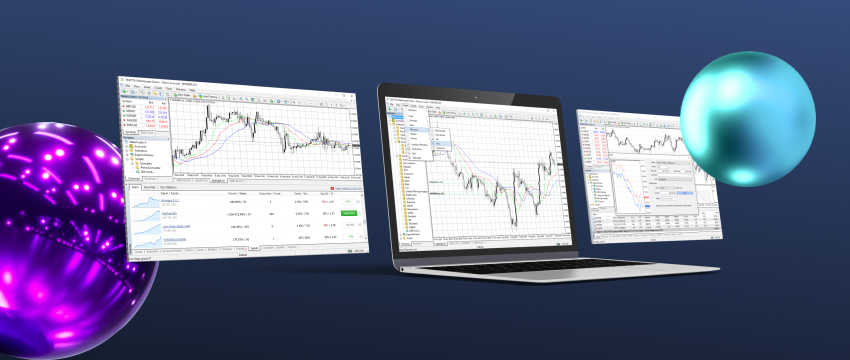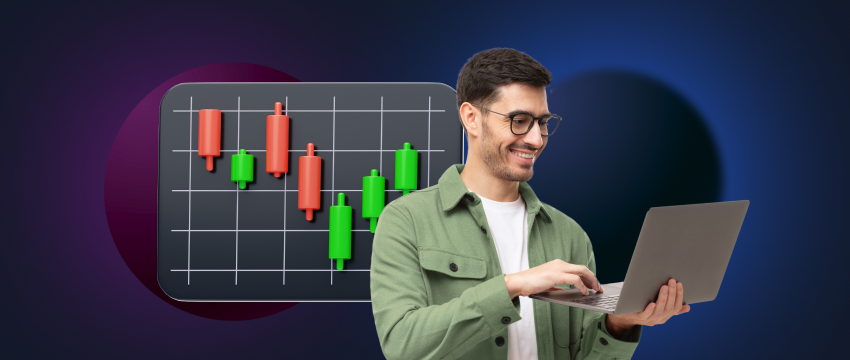واحدة من أكثر الأسئلة المثارة جدلًا في التداول هي أي نوع من التحليل، الأساسي أم الفني، هو الأنسب. غالبًا ما يكون لدى المتداولين والخبراء الماليين آراء قوية حول أي نهج يؤدي إلى نتائج محتملة أفضل.
<pيعتقد البعض أن فهم الأساسيات الاقتصادية والمالية للأصل هو الطريقة الوحيدة لاتخاذ قرارات تداول مستنيرة. بينما يجادل آخرون بأن أنماط الرسوم البيانية وسلوك السوق تزودك بكل ما تحتاج لمعرفته.
في الواقع، لكل من التحليل الأساسي والفني مزايا وعيوب. لا توجد طريقة مثالية، حيث يناسب كل منهما متداولين مختلفين حسب احتياجاتهم وأهدافهم وأفقهم الزمني وتحملهم للمخاطر.
يستعرض هذا المقال معنى التحليل الأساسي والفني، ويعرض الفروقات الرئيسية بينهما، ونقاط قوتهما وضعفهما، ويشرح كيف يقوم المتداولون بدمجهما لتحقيق توازن في استراتيجياتهم.
في النهاية، يجب أن تفهم بوضوح أي نهج يناسب أسلوب تداولك أو ما إذا كان الجمع بين الاثنين هو الخيار الأفضل.
ما هو التحليل الأساسي؟
يركز التحليل الأساسي على الصورة الكبرى، ويدرس ما الذي يحدد قيمة الأصل. بالنسبة للأسهم، قد يشمل ذلك دراسة أرباح الشركة، والميزانيات العمومية، وقرارات الإدارة، أو توقعات الصناعة.
بالنسبة لعملات الفوركس، قد يشمل ذلك متابعة أسعار الفائدة، ومعدلات التضخم، وبيانات التوظيف أو النمو الاقتصادي بشكل عام. كما أن العرض والطلب والأحداث الجيوسياسية تؤثر أيضًا على السلع.
يركز التحليل الأساسي على تحديد ما إذا كان الأصل مقوَّمًا بأقل من قيمته أو بأكثر من قيمته بناءً على قيمته الحقيقية أو الجوهرية. على سبيل المثال، تخيل متجرًا يبيع أحذية قيمتها 70 دولارًا لكنها معروضة للبيع بسعر 50 دولارًا. سيرى المشتري في ذلك فرصة شراء جيدة.
يفضل المتداولون على المدى الطويل التحليل الأساسي لأنه يركز على النمو والاستقرار بدلًا من تغييرات الأسعار قصيرة المدى.
ما هو التحليل الفني؟
من ناحية أخرى، التحليل الفني مختلف تمامًا. يختلف لأنه يركز على تحركات الأسعار، وأنماط الرسوم البيانية، واتجاهات السوق بدلاً من الأساسيات الجوهرية.
يعتمد التحليل الفني على البيانات التاريخية والمؤشرات الإحصائية. ويفترض أن جميع المعلومات ذات الصلة قد انعكست بالفعل في السعر، وأن سلوك السوق يميل إلى التكرار بمرور الوقت.
في هذا النهج، يقوم المتداولون بفحص رسوم الأسعار وأنماط السوق. كما يستخدمون مؤشرات مثل المتوسطات المتحركة، ومستويات الدعم والمقاومة، أو المؤشرات المتذبذبة مثل مؤشر القوة النسبية (RSI).
يدور التحليل الفني حول فكرة رئيسية واحدة. فهو يفترض أن السعر الحالي للسوق لأي أصل يعكس بالفعل جميع المعلومات المتاحة.
يشمل ذلك أداء الشركة، والبيانات الاقتصادية، والأحداث السياسية، ومزاج المستثمرين. وهذا يعني أن المتداولين يمكنهم مراقبة تحركات الأسعار، ورصد الاتجاهات، أو محاولة التكهن بالخطوة التالية للسوق.
يستخدم المتداولون قصيرو الأجل، مثل متداولي السوينغ أو المتداولين اليوميين، التحليل الفني لأنهم يجب أن يتفاعلوا بسرعة مع تغيرات الأسعار. الانتظار لتقارير الشركة أو إصدارات الأخبار الاقتصادية سيستغرق وقتًا طويلاً. لهذا يعتمدون على الرسوم البيانية لتحديد متى يشترون أو يبيعون.

لماذا نستخدم التحليل الأساسي؟
أكبر قوة للتحليل الأساسي هي قدرته على توفير فهم شامل للقيمة الحقيقية للأصل. عند دراسة الصحة المالية لشركة أو استقرار الاقتصاد في دولة ما، يمكن للمتداولين اتخاذ قراراتهم بناءً على الحقائق بدلاً من المعلومات قصيرة المدى.
أثناء حالات الذعر في السوق، على سبيل المثال، قد تنخفض الأسعار إلى مستوى أقل من قيمتها العادلة. يمكن لـ المتداول الأساسي المطلع الاستفادة من ذلك عن طريق شراء الأصول القوية بخصم والاحتفاظ بها حتى يتعافى السوق.
بالإضافة إلى ذلك، يُعد التحليل الأساسي مفيدًا للتخطيط على المدى الطويل. فهو يمكّن المتداولين من بناء محفظة تتنامى بشكل مستمر على مر السنين. وليس الأمر متعلقًا بتخمين سعر الغد بقدر ما هو عن تحديد الشركات أو العملات التي ستظل قوية على المدى الطويل.
لماذا نستخدم التحليل الفني؟
إذا كنت تبحث عن المرونة والسرعة، فإن التحليل الفني هو النوع المناسب من التحليل بالنسبة لك. ينظر المتداولون الفنيون إلى أنماط الرسوم البيانية لاتخاذ القرارات بسرعة، دون الحاجة للانتظار لتقارير ربع سنوية أو تحديثات اقتصادية.
يوفر هذا النوع من التحليل أيضًا أدوات لإدارة المخاطر. مستويات وقف الخسارة، والمتوسطات المتحركة أو خطوط الاتجاه هي مؤشرات تساعد المتداولين على تحديد نقاط الدخول والخروج بوضوح. تساعد هذه الانضباطية في فترات تقلب السوق، حيث تتغير الأسعار بسرعة.
يمكن للمتداولين تطبيق التحليل الفني على نطاق واسع على أدوات مختلفة مثل الأسهم، والفوركس، والسلع. يتركز تركيزه الأساسي على حركة الأسعار، كما تم ذكره سابقًا. لذلك، يطبق المتداولون نفس المبادئ بغض النظر عن الأصل الذي يتداولونه.
حدود التحليل الأساسي والفني
قد يكون هناك نقاط قوة في كلا النوعين من التحليل، لكن هناك أيضًا نقاط ضعف. يظهر التحليل الأساسي تأثيره في السوق ببطء شديد. قد يستغرق الأمر شهورًا أو حتى سنوات حتى تصل الشركة المقومة بأقل من قيمتها إلى قيمتها العادلة.
يمكن أن يسبب هذا إحباطًا للمتداولين الذين يسعون لتحقيق الأرباح بأسرع وقت ممكن. كما أنه يعتمد بشكل كبير على الافتراضات والتكهنات، والتي قد تكون أحيانًا غير دقيقة.
من ناحية أخرى، يعتبر العديد من المتداولين أن التحليل الفني يعتمد بشكل مفرط على الأنماط التي قد لا تتكرر. حقيقة أن سهمًا قد اتبع اتجاهًا في السابق لا يعني أن الأمر نفسه سيتكرر في المستقبل. يعتقد البعض أيضًا أن المؤشرات الفنية قد تصدر أحيانًا إشارات متناقضة، مما قد يربك المتداولين.
التحليل الأساسي والفني: ملخص الفروقات
يختلف النوعان من التحليل في تركيزهما الرئيسي. كما ذُكر سابقًا، يدرس التحليل الأساسي الأسباب التي تجعل الأصل يستحق قيمة معينة، بينما يركز التحليل الفني على توقيت الدخول أو الخروج من الصفقة بناءً على حركة السعر.
فيما يلي نلخص ثلاث فروقات رئيسية بينهما:
الإطار الزمني: يعمل التحليل الأساسي بشكل أفضل للتداول طويل الأجل. يُستخدم التحليل الفني بشكل رئيسي من قبل المتداولين قصيري الأجل.
البيانات المستخدمة: يستخدم التحليل الأساسي البيانات الاقتصادية والمالية، بينما يشمل التحليل الفني الرسوم البيانية والمؤشرات.
القرارات المتخذة: يحدد التحليل الأساسي ما إذا كان الأصل مقومًا بأقل من قيمته أو بأكثر من قيمته، بينما يركز التحليل الفني على توقيت السوق.
على الرغم من أن النوعين من التحليل السوقي يبدوان مختلفين تمامًا، إلا أنه يمكن دمجهما للحصول على صورة أكثر شمولية.

هل يمكن استخدام التحليل الأساسي والفني معًا؟
هناك الكثير من المتداولين ذوي الخبرة الذين يعتقدون أن أفضل نهج هو دمج التحليل الأساسي والفني معًا. من خلال ذلك، يمكنهم الاستفادة القصوى من نقاط القوة في كلا التحليلين.
قد يستخدم المتداول التحليل الأساسي للعثور على شركة قوية ذات آفاق نمو جيدة. ولكنه يمكنه أيضًا استخدام التحليل الفني لتحديد أفضل وقت لدخول الصفقة، بعد البحث عن نمط رسومي مناسب.
عند التداول في سوق الفوركس، قد يبحث المتداولون عن سياسات أسعار الفائدة لاختيار العملات التي سيتداولون بها، مع تحليل الرسوم البيانية أيضًا لتحديد مستويات الدخول والخروج، مع الاعتماد بذلك على مصادر معلومات متعددة.
خاتمة
هناك جدل كبير مستمر منذ سنوات بين التحليل الأساسي والفني. على الرغم من أن لكل منهما نقاط قوة وضعف وداعمين، من المهم أن نتذكر أن كلاهما مجرد أدوات.
يوفر التحليل الأساسي منظورًا طويل الأجل مع مساعدة المتداولين على فهم القيمة الحقيقية للأصل، بينما يركز التحليل الفني على التوقيت والفرص قصيرة الأجل.
سيعتمد الاختيار بين الاثنين على أهدافك التداولية. ومع ذلك، يجد العديد من المتداولين أن الجمع بين النهجين يخلق استراتيجية أكثر توازنًا واستنارة.
في النهاية، الأمر لا يتعلق بمن يكسب، بل بماهية الطريقة التي تساعدك على اتخاذ قرارات أفضل. أيا كانت الطريقة، فإن النمو يأتي مع الممارسة والانضباط والاتساق.
إخلاء المسؤولية: هذه المواد مخصصة للأغراض الإعلامية والتعليمية العامة فقط ولا ينبغي اعتبارها نصيحة استثمارية أو توصية استثمارية. T4Trade ليست مسؤولة عن أي بيانات مقدمة من أطراف ثالثة مشار إليها أو مرتبطة برابط في هذا الاتصال.




